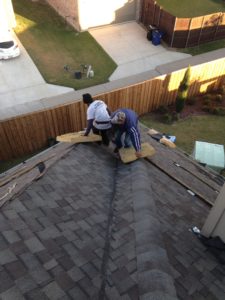 Like other occupations, roofing professionals have their own words and terms to describe the parts of a roof system. If you are familiar with the terminology, you can feel more confident when reviewing a quote, asking questions or explaining what you want. The following list covers the most common terms you are likely to encounter when hiring a contractor to replace or repair your roof.
Like other occupations, roofing professionals have their own words and terms to describe the parts of a roof system. If you are familiar with the terminology, you can feel more confident when reviewing a quote, asking questions or explaining what you want. The following list covers the most common terms you are likely to encounter when hiring a contractor to replace or repair your roof.
Asphalt Shingles
The most popular type of roof covering in the United States, asphalt or composite shingles consist of an asphalt-impregnated organic or fiberglass substrate that is then covered with a top layer of colored granules.
Base Ply
In a roofing system, the main ply of material is the base ply.
Base Sheet
Some modified bitumen or built-up roof systems use a coated or asphalt-impregnated felt for the first ply.
Built-up Roof
Low-slope or flat roofs typically require a built-up roof that alternates layers of felt and bitumen before topping with a granulated cap sheet.
Closure Strip
These strips are used to close gaps between flashings and sheets or metal roof panels.
Cornice
The metal or wood finishing crowning a building’s wall, including a rake, frieze or fascia is called a cornice.
Drip Edge
Drip edge is the metal strip that extends past the eaves to channel water away from the building’s walls and prevent water from flowing back underneath the shingles.
Eaves
Eaves, which may extend beyond the walls of the structure, are the lower edges of the roof.
EPDM
Ethylene propylene diene monomer is synthetic rubber frequently used as a membrane on flat or low-slope roofs.
Fascia
Fascia boards extend down from the roof’s edge at the rake or eaves.
Felt
Roofing felt is composed of either rags or paper that has been impregnated with asphalt.
Flashing
Flashing is used to waterproof openings caused by roof penetrations, such as vents, or at intersecting planes, such as where a roof meets a wall.
Frieze Board
Frieze boards appear at the top of a structure and form a corner with the soffit.
Guard — Eave, Ice or Snow
Guards are typically rubber strips about three feet in width placed at the roof’s edge to help stop water from penetrating the interior if snow accumulates or an ice dam forms.
Gutter
Gutters are the troughs fastened beneath the roof’s edge to carry water to downspouts or drains.
Joint Tape
Roofers use joint tape to seal the seams between adjacent insulation boards.
Laced Valley
Laced or woven valleys can be used where two sloping roof planes meet and are formed by overlapping shingles from each side of the valley.
Pitch
The pitch or slope of a roof represents how many inches the roof rises vertically for every foot of horizontal distance.
Plastic Cement
A generic term used by the roofing industry to describe Type I asphalt cement, plastic cement is designed for use on areas with low slopes.
Ply
A ply is a layer of reinforcing material, ply sheet or felt.
Rafter
Rafters are the wood or metal structural supports to which the roof’s deck is attached.
Rake
On a gable roof, rakes are the slanted edges at the building’s end walls.
Ridge
The ridge is the top horizontal edge where two roof planes meet.
Ridge Cap
Ridge cap is the material covering a ridge.
Sheathing
Roof sheathing, also called decking, refers to the plywood sheets or boards that are attached to the rafters and to which roofing materials are secured.
Soffit
Soffit is the enclosed area underneath the portion of the roof that extends past the building’s walls.
Square
In roofing, a square is equivalent to the amount of material required for 100 square feet of roof area.
Underlayment
Underlayments are the felts or other membranes that are attached to the decking before installing shingles.
Valley
Valleys are the depressions formed where two sloping roof planes meet.
Valley Flashing
Valley flashing is a fabric or metal strip covering a valley that is tucked beneath the edges of the shingles on each of the valley’s two sides.
For Additional Help
At Alpha Roofing, we understand that roofing terminology can be confusing a roofing glossary is needed. We have more than 35 years of experience in the industry, so we understand how to communicate information to customers. We offer a wide variety of services to customers throughout Central Texas, including re-roofs, roof repairs, metal roofing systems, siding installation, skylight repairs and much more. You can request a free quote through our online form or by calling our office at (512) 777-1086.
